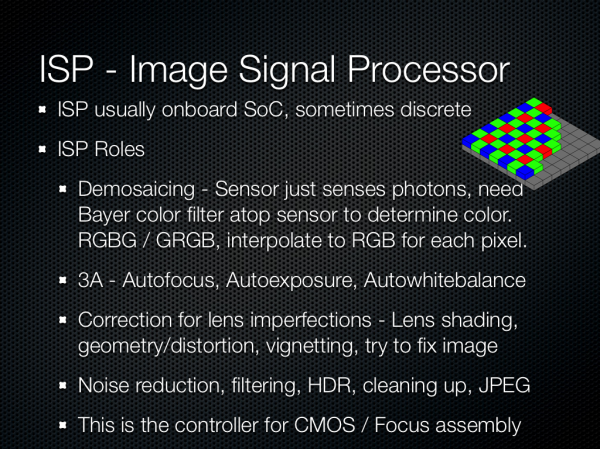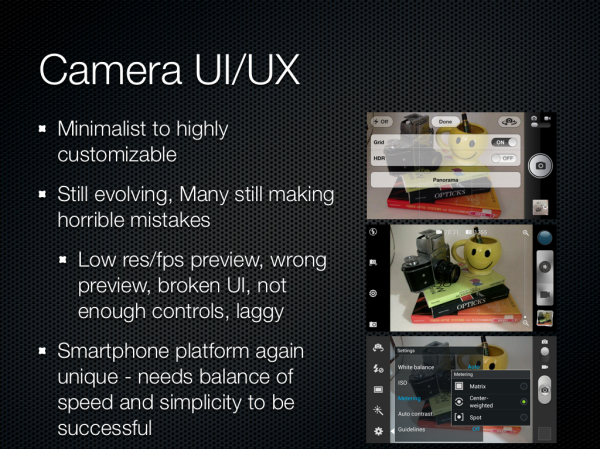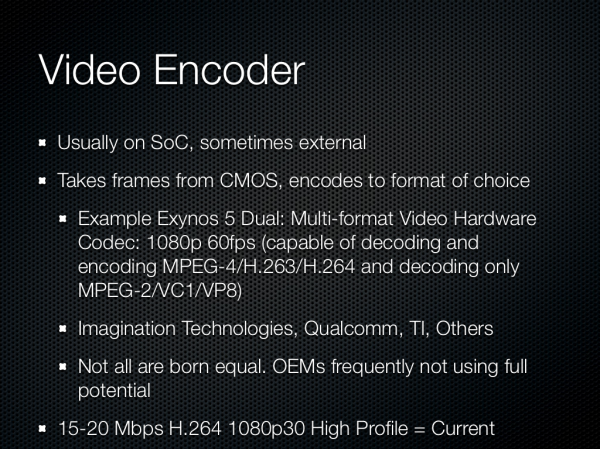Understanding Camera Optics & Smartphone Camera Trends, A Presentation by Brian Klug
by Brian Klug on February 22, 2013 5:04 PM EST- Posted in
- Smartphones
- camera
- Android
- Mobile
The Image Signal Processor (ISP)
So what purpose does ISP have? Well, pixels are sensitive to light between some set of wavelengths, essentially they’re color agnostic. The way to get a color image out is to put a filter on top, usually a bayer pattern color filter, then interpolate the color of the pixels adjacent. Your 8 MP CMOS doesn’t sense red green and blue for each pixel, it senses one color for each, then ISP guesses the color based on what’s next to it. This is called demosaicing, and it’s probably the primary job of ISP, and there are many secret sauce methods to computing this interpolated image. In addition ISP does all the other housekeeping, it controls autofocus, exposure, and white balance for the camera system. Recently correcting for lens imperfections like vignetting or color shading imparted by the imperfect lens system (which you’ll add right back in with instagram, you heathen) has been added, along with things like HDR recombining, noise reduction, other filtering, face or object detection, and conversion between color spaces. There’s variance between the features that ISP does, but this is really the controller for getting that bayer data into a workable image array.
Obviously the last part is the human interface part of the equation, which is an ongoing pain point for many OEMs. There are two divergent camps in smartphone camera UX – deliver almost no options, let the ISP and software configure everything automatically (Apple), and offer nearly every option and toggle that makes sense to the user (Samsung). Meanwhile other OEMs sit somewhere in-between (HTC, others). The ideal is an opt-in option for allowing users to have exposure control, with safe naive-user defaults. There are still many players making horrible, almost unthinkable mistakes in this area too. I wrote about how the iPhone 5 crops the preview to a 16:9 size, yet captures a 4:3 image, and later was amazed to see the AOSP camera UI on the Nexus 4 deliver an arbitrary shape (not even 16:9 or something logical) crop in the preview, and also capture a 4:3 image. Composition unsurprisingly matters when taking a photograph, and it’s mind-blowing to see established players blow off things like preview. In addition, preview framerate and resolution can be an issue on some platforms, to say nothing of outright broken or unstable user interfaces on some devices. Many OEMs have been thrust into crafting a camera UI who really have limited to no camera experience — previously it was a feature to have a camera period, much less controls. As the smartphone evolves from being a camera of convenience to the primary imaging device for most people, having robust controls for when ISP and auto exposure functionalities fail will become important. Right now camera UI and UX is rapidly changing from generation to generation, with more and more serious toggles being added. I don’t think any one player has a perfect solution yet.
For video we need to also consider the encoder. The pipeline is much the same, though the ISP will usually request a center crop or subsample from the CMOS, depending on the capabilities of the sensor. The encoder takes these images and compresses them into a format and bitrate of the OEM or user’s choice, basically H.264 at present. Not every encoder is the same, as Ganesh will tell you. There are a number of players in this market supplying IP blocks, and other players using what they have built in-house. Many OEMs make interesting choices to err on the side of not using too much storage, and don’t encode at the full capabilities of the encoder. This latest generation of phones we saw settle somewhere between 15 and 20 Mbps H.264 high profile for 1080p30 video.













60 Comments
View All Comments
ltcommanderdata - Saturday, February 23, 2013 - link
http://www.sony.net/SonyInfo/News/Press/201208/12-...Sony's new Exmor RS sensors use a stacked structure which places the circuit section underneath the pixel section instead of beside it which should free up more room for more pixels or larger pixels within a given sensor module area or enable smaller modules. They also add a dedicated white channel for a RGBW coding which they claim improves low light performance. Any comment on the efficacy of these techniques?
Apple has been using Sony image sensors for both the iPhone 4S and iPhone 5 so that new Sony IMX135 with 13.13MP, 1/3.06", 1.12 μm pixel sensor looks like a prime candidate for the iPhone 5S.
slatanek - Saturday, February 23, 2013 - link
Well done, Brian. At last someone trying to explain and stress how much more is there to tiny smartphone cameras than just the megapixels. A few years ago I felt like we got over it and the race was over, but now few years later the race just continues but in the smartphone realm (previously compact cameras had the same issues where ultimate picture quality was compromised just to get to a higher number of megapixels on the box). Hopefully this will change in near future, but somehow I'm afraid that were stuck with it just as with the horrible quality displays in notebooks. And it's not that people don't want good quality, it's just that the behemot companys are not willing to take the risk.Anyways, thanks for a good read.
Shftup - Saturday, February 23, 2013 - link
Brain - Well done!This is a fanatastic article. Its well written, relatively easy to understand for any layman, and most importantly makes the reader coming back for more.
jabber - Saturday, February 23, 2013 - link
....for a smartphone to give me as good a picture quality as I got from my 3.2MP Nikon from 2004.When I find one I'll be happy.
I think a lot of the phone companies need to start poaching the optics and software specialists from the camera companies. It's all very well looking at the spec lists for components but its another thing entirely to make them all work together to produce a decent picture.
In the past for me near decent cams have been ruined by over zealous compression settings (Palm Pre2) or what appears to be zero configuration of the imaging processors (Nexus4).
No one yet has tweaked every part of the chain to provide a truly viable alternative to taking a $250+ camera along instead.
Never had anything to do with megapixels IMO. It's other factors that let them down.
I reckon in another 2 years we'll have it pretty much there.
MrSpadge - Sunday, February 24, 2013 - link
Same here, my Sony DSC-W5 from 2005 or so is still way better than my smartphone. If I could get at least similar quality in a new phone that would easily make it worth 50 - 100€ more for me.Tarwin - Saturday, February 23, 2013 - link
I enjoyed the article, it cleared up some doubts I had and taught me a few new things.In light of this article I hope you go into more detail in the One review when you eventually do it. I assume you will give special attention to the c amera due to how it goes against the trend and HTC's focus on it but I also hope you mention how it fits into all this a bit for those of us who read both articles. Thanks again.
DominicG - Saturday, February 23, 2013 - link
Hi Brian,much enjoyed your intro to camera optics. However you state:
"If we look at the airy disk diameter formed from a perfect diffraction limited ... we get a spot size around 3.0 microns"
You mentioned this is a back illuminated chip so that the light is focussing in a medium of refractive index ~3.5. Therefore the wavelength of red light inside the medium is ~700/3.5 = 200nm - still much smaller than the pixel. It is a bit more complicated than this since the optical resolution is of course determined not only by the wavelength but also the numerical aperture (NA) - the light refracts at the air-silicon interface so that a beam in air at 37 deg (2omega =75deg - your example lens), becomes a beam in silicon of only 10 deg. 10 deg in silicon gives a theoretical resolution (Rayleigh condition) of 0.7microns. Anyway, did you take all these factors into account?
fokka - Sunday, February 24, 2013 - link
thanks for this insightful article, brian, that's the sort of read i i visit this site for regularly!i have to say that i expected a little more (side-) content, though, like a more thorough look at the htc one initially pictured, one of the two reasons i clicked on the article. also a comparison with nokias pureview-approach would've been nice, since it's on the complete other side of the spectrum.
but this is just to nitpick, as i enjoyed the read none the less.
StormyParis - Sunday, February 24, 2013 - link
Great articleStormyParis - Sunday, February 24, 2013 - link
Seeing the interest everyone has in good pictures, and the relatively small size and cost of the lens apparatus, wouldn't it make sense to have 2 distinct cameras on a smartphone, and coordinate them to get better image quality ?